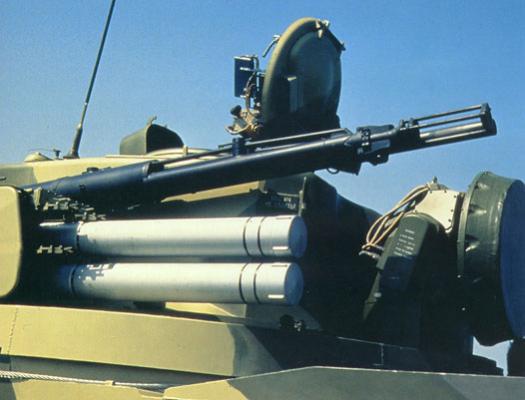Tunguska" combat vehicle target detection station is a coherent pulse radar with a circular view of the decimeter wavelength range. High stability of the transmitter frequency, made in the form of a setting generator and amplifier circuit, the use of filter circuit selection of moving targets provides a high coefficient of suppression of reflections from local objects (30 ... 40 dB), which allows the detection of targets against the background of intense reflections from the underlying surface and in passive interference. The selection of carrier frequency values and pulse repetition frequency was achieved unambiguous definition of range and radial velocity, which made it possible to implement target tracking by distance and azimuth, automatic target designation of the target tracking station and the current range output to the digital computer system when the enemy set the intensive interference in the range of the tracking station. To ensure the operation in motion, the antenna was electromechanically stabilized using signals from sensors of the swing measurement system and the self-propulsion course.
With the impulse power of 7-10 kW transmitter, receiver sensitivity of about 2x10E-14 W, width of the antenna's orientation diagram by 5° azimuth and 15° angle, the station with the probability of 0.9 provided detection of the fighter flying at altitudes 25-3500 m at a range of 16-19 km. The station's resolution was 500 m in range, 5-6° in azimuth and within 15° on the corner of the place. Mean-square target coordinate errors were within 20 m range, 1° azimuth and 5° angle.
Target tracking station is a coherent impulse radar of centimeter range with a two-channel system of tracking by angular coordinates and with filter schemes of selection of moving targets in the channels of autodalometer and angular auto tracking. The passive noise and reflection suppression factor from local objects was 20-25 dB. The station made the transition to auto tracking in the target designation and sector search modes. The search sector was 120° in azimuth and 0-15° in angle.
At pulse power of the transmitter 150 kW, the sensitivity of the receiver 3x10E-13 W, the width of the antenna 2 degrees. (by azimuth and angle of position) station with a probability of 0.9 provided a transition to auto tracking on three coordinates flying at an altitude of 25 - 1000 m fighter from a range of 10:13 km (with target designation from the target detection station) and from 7.5:8.00 km (with a separate sector target search). The station's resolution was no worse than 75 m in range and 2 degrees in angular coordinates. RMS errors of target tracking at a range of 2 m and 2 degrees in angular coordinates were not worse than 75 m in range and 2 degrees in angular coordinates.
Target detection and tracking stations successfully detected and escorted low-flying and hovering helicopters. The range of detection of the helicopter flying at a speed of 50 m/s at an altitude of 15 m, with a probability of 0.5 was 16-17 km, the range of transition to car escort - 11-16 km. Hanging helicopter was detected by the detection station on the Doppler shift of frequency from the rotating screw and took on auto tracking on three coordinates by the target tracking station.
The stations had circuit-based protection against active interference, as well as the ability to escort the target in the interference through combinations of radar and optical war machine. Due to these combinations, differences in operating frequencies of the stations, time regulated working frequencies or simultaneous operation at close frequencies of several (distant from each other at a distance of more than 200 m) combat vehicles in the battery could provide reliable protection against missiles such as "Shrike" or "Standard - ARM".
